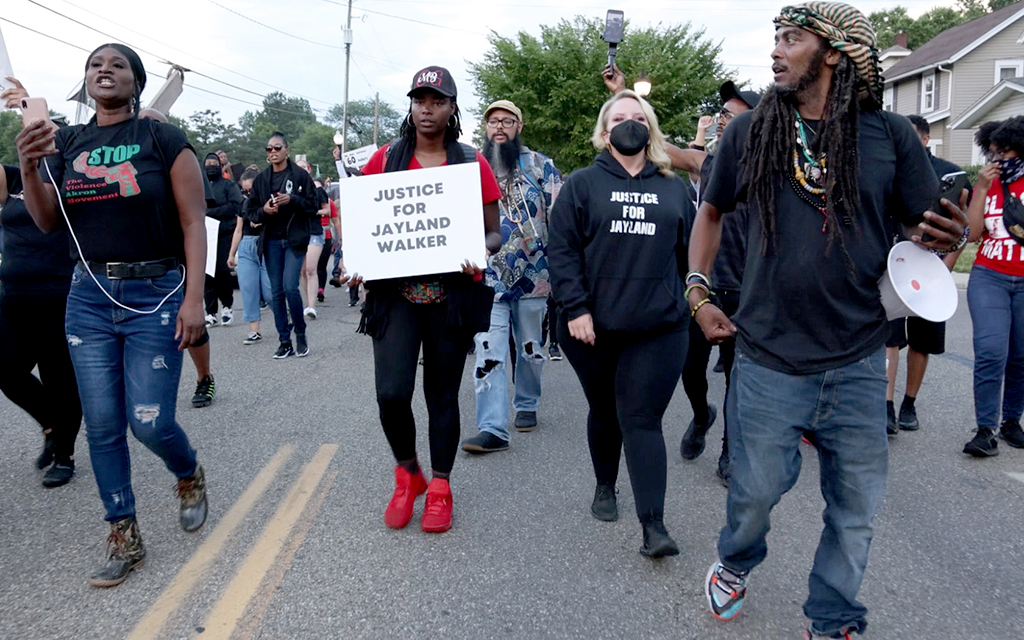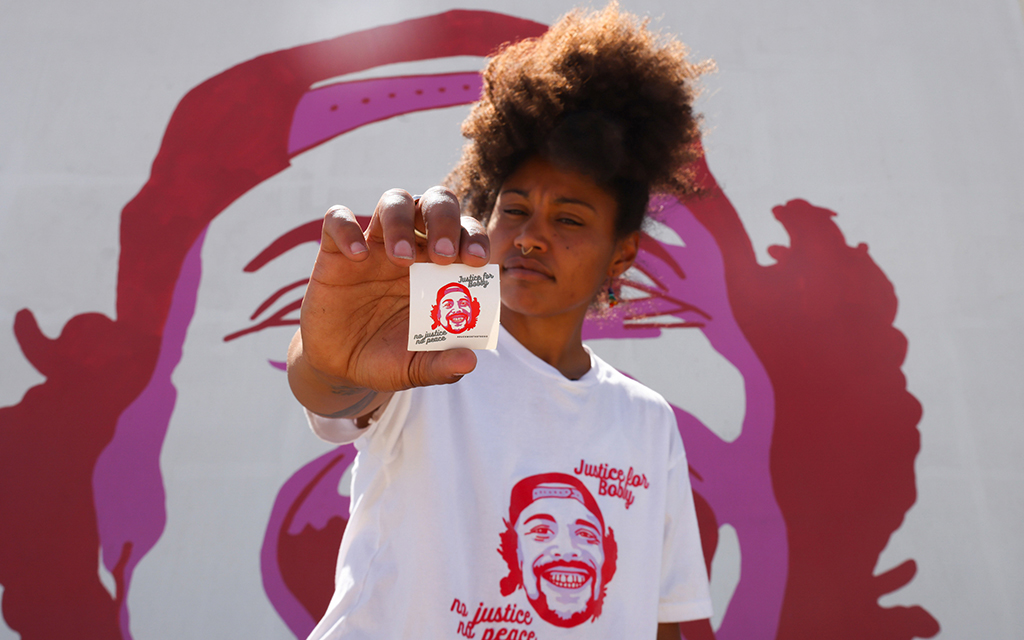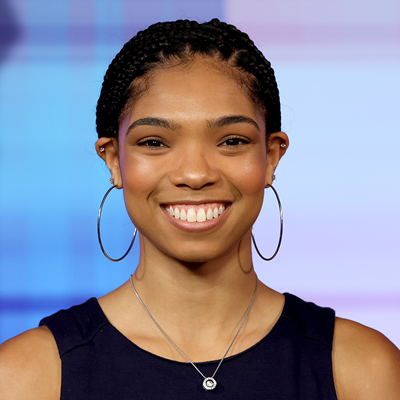Communities are pushing for change after minor traffic stops lead to lives lost
MINNEAPOLIS – It took Katie Wright 12 minutes to get to where her son, Daunte Wright, took his last breaths after being shot by police in suburban Brooklyn Center last year.
One month later, she was working in city hall, collaborating on a policy to prevent something like this from happening again. She and city officials and community leaders are pushing for such reforms as a ban on low-level traffic stops and a proposal to have unarmed civilians conduct such stops.
Daunte Wright was pulled over on April 11, 2021, for a minor traffic stop. Officer Kim Potter, who testified that she mistakenly drew her handgun instead of her Taser, in February was convicted of manslaughter and sentenced to two years.
“I don’t ever want another family to feel how I felt when I got that phone call,” Wright said. “It was like somebody ripped my whole entire heart out. If I can stop that feeling from happening, I will do that.”
Since that night last year when her son never made it home for dinner, Wright has spent many hours in government buildings in Brooklyn Center, a city 10 miles north of Minneapolis, working to change traffic laws. She and other members of the city’s committee to implement reforms, which includes other activists, the mayor and other city officials, hope to prevent deaths that can start with minor offenses – such as an air freshener illegally hanging from a mirror.
“It’s absolutely crazy that you have somebody with a gun stopping your car on the road as you’re driving to work, or to school, or to your birthday party, to a wedding or wherever you’re going in America,” Brooklyn Center Mayor Mike Elliott said.
Traffic stops are among the most common interactions between police and public. A June 2021 Rand report says that out of more than 60 million people who police encountered in 2018, 25 million were drivers or passengers in traffic stops.
“It is increasingly seen as a practice that, if stopped, would serve the cause of social justice,” RAND researcher Bob Harrison writes.
Racial disparities are entrenched in traffic stops. Black drivers nationwide are about 20% more likely to be stopped – and almost twice as likely to be searched – according to a 2020 study of almost 100 million traffic stops conducted by the Stanford Open Policing Project.
Since 2020, at least seven cities and Virginia have banned low-level traffic stops, such as expired registration tags, broken taillights and other minor, non-moving violations that reform advocates say often are pretexts for drugs and weapons searches.
Others, including Berkeley, California, and Brooklyn Center, are considering training unarmed civilians to conduct such stops. Another approach is through technology, such as texting drivers and relying on red-light cameras. Such responses are just getting started, making it difficult to gauge their effect.
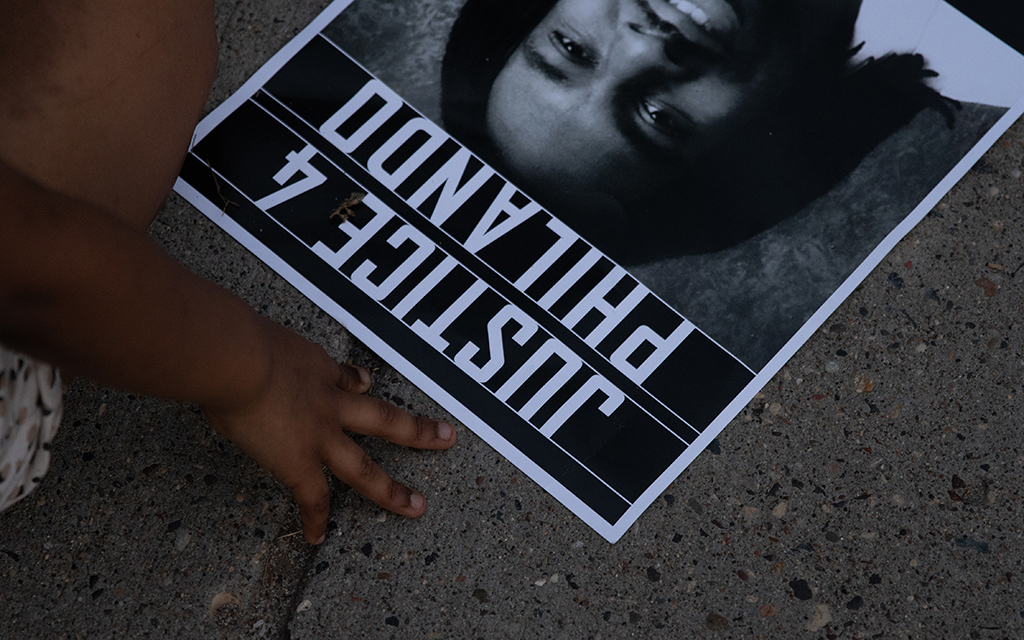
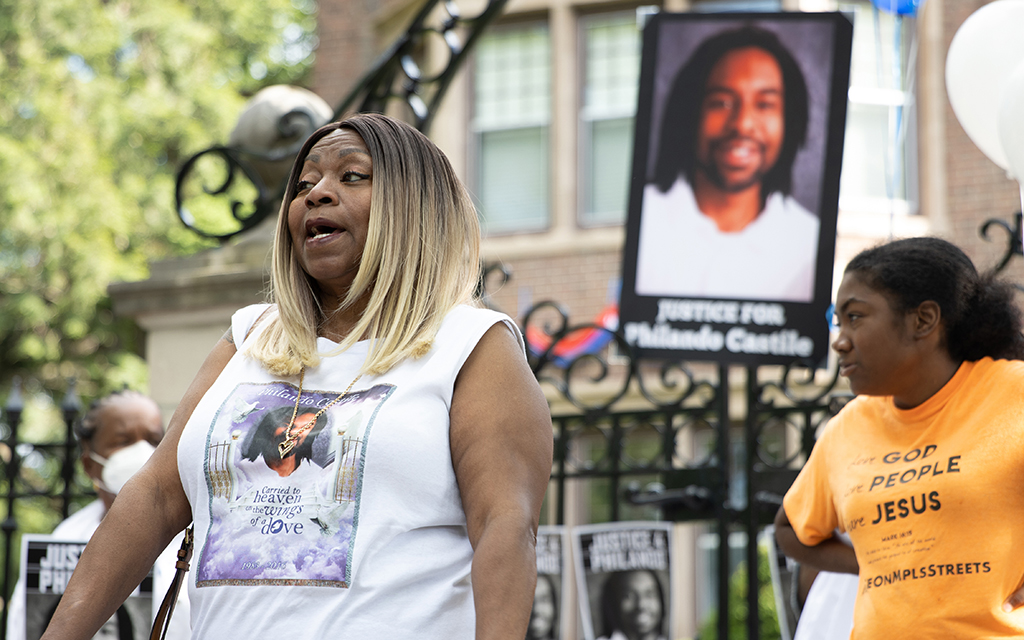
Left: A “Justice 4 Philando” poster lies on the floor at a candlelight vigil, Wednesday, July 6, 2022 in Falcon Heights, Minnesota. Right: Valerie Castile speaks at a police-reform rally in front of the governor’s mansion in St. Paul, Minnesota, on Wednesday, July 6, 2022 – the sixth anniversary of the killing of her son, Philando Castile, after a traffic stop. (Photos by Diannie Chavez/News21)
Top: A “Justice 4 Philando” poster lies on the floor at a candlelight vigil, Wednesday, July 6, 2022 in Falcon Heights, Minnesota. Bottom: Valerie Castile speaks at a police-reform rally in front of the governor’s mansion in St. Paul, Minnesota, on Wednesday, July 6, 2022 – the sixth anniversary of the killing of her son, Philando Castile, after a traffic stop. (Photos by Diannie Chavez/News21)
Reluctant epicenter
A sculpture of a raised fist. Bursts of flowers. Murals marking walls and the boarded up windows that are the reminders of grief and anger in Minneapolis. George Floyd Square, at 38th Street and Chicago Avenue, is a living memorial to the man whose May 2020 murder by police ignited an international outcry and global movement for police reform. Minneapolis and its suburbs have become the reluctant epicenter of police violence, protest and reform.
On a July day, less than 10 miles from the square, outside the governor’s mansion, Valerie Castile led a call-and-response protest on the sixth anniversary of her son’s death during a traffic stop.
“Say his name!” she shouted.
“Philando Castile!” the crowd shouted back, their voices rising as they held signs: “Justice 4 Philando and All Stolen Lives.”
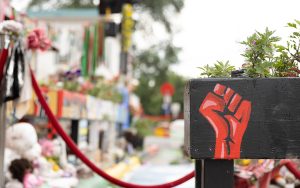
A fist painted at a garden at George Floyd Square, Thursday, July 7, 2022, in Minneapolis. (Photo by Diannie Chavez/News21)
Philando Castile died in his car, shot by police in 2016 during a traffic stop for a broken taillight in Falcon Heights, about 10 miles east of Minneapolis.
“He was defenseless, he was strapped down in that car, nowhere to go, nowhere to hide, nowhere to duck, he couldn’t run away,” Valerie Castile told the crowd. “His hair was the thorn crown, the seatbelt was the cross, and the bullets were the nails and that car was his coffin.”
Eleven months after George Floyd was murdered, Daunte Wright was shot to death in Brooklyn Center after a traffic stop. Police said it was for expired tags, but Wright – who spoke with Daunte just before the fatal scuffle – said he told her it was for air freshener hanging from his rearview mirror.
Hilary Rau, vice president of policy for the Center for Policing Equity, said the public wants change.
“I think that in the wake of the killings of Daunte Wright, Philando Castile, some of these police killings that began as a result of very low-level traffic stops, there was just this upsurge of community demand of ‘Can’t we do better than this?’” she said.
“Isn’t there some better way to address a broken taillight or something hanging from a rearview mirror than to have someone with a gun going after this?”
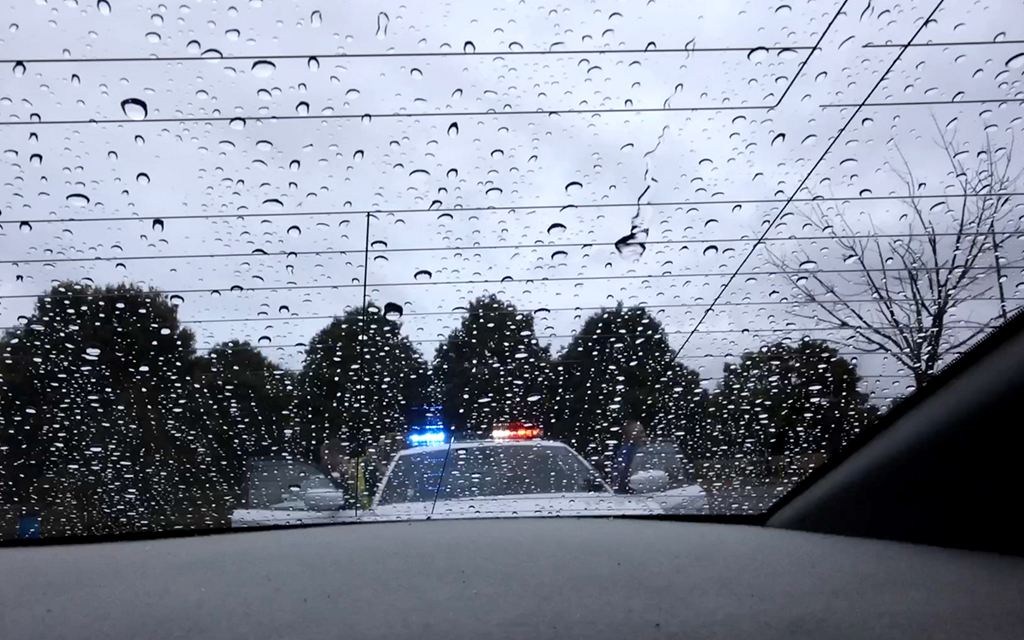
A training officer with the Indianapolis Metropolitan Police Department conducts an exercise on Friday, July 8, 2022. Some police departments, including the one in Brooklyn Center, Minnesota, are considering placing civilians in charge of traffic stops rather than armed police officers. (Photo by Reagan Creamer/News21)
Ending pretextual stops
Only a few of America’s more than 19,000 municipalities – including Philadelphia, Pittsburgh, Minneapolis, Brooklyn Center, Seattle, Los Angeles and Lansing, Michigan – have taken steps to abolish low-level traffic stops. Virginia is the only state to do so.
Philadelphia banned such stops on Oct. 14, 2021, with the Driving Equality Policy, which took effect three months later. In April 2022, Pittsburgh followed.
“I’ve been pulled over more times than I can count, and for me, not only is it something that can often be humiliating, we know that the numbers tell us that it does not deter crime,” said Isaiah Thomas, a Philadelphia City Council member. “It puts us in a position where we’re destroying the relationship between communities of color and law enforcement.”
In Virginia, lawmakers in late 2020 moved to ban stops that historically have been used for so-called pretextual stops for such violations as dark window tint or defective taillight – a reason to halt and question drivers suspected of other crimes, including carrying guns or drugs.
“So many of these high profile cases were police conducting pretextual stops,” said Brad Haywood, executive director of Justice Forward Virginia, “and then getting freaked out and then killing someone.”
David Harris, a University of Pittsburgh law professor, said governments historically have recognized opportunity in making certain traffic offenses illegal. In many jurisdictions, officers can stop motorists for a slew of offenses: invalid or expired registration, a broken license-plate light or improperly displayed license plate, a cracked or discolored windshield, rearview mirror decorations, too-dark window tinting, and broken headlights, taillights and turn signals.
“They understood that once these things were criminal offenses, and police had a role in enforcing these things, maybe the dominant role, this could be used for purposes other than ensuring that you didn’t go too fast for your neighbors to be safe,” Harris said.
As the war on drugs arrived in the 1970s, traffic enforcement translated to power, he said.
“By the time you get to the 1960s, ’70s and ’80s, driving is so universal,” Harris said. “Basically, you can stop anybody traveling in a vehicle anytime you want if you’re a police officer. All you had to do was follow him for a few blocks.”
Those who are affected, Wright and other reform advocates said, are those who can least afford to pay for car repairs.
“If you are able to afford to get your tabs (car registration tags), you are going to, or if you’re able to fix your taillight, you’re of course going to,” Wright said. “But if you’re going to drive to work because you don’t get paid until next Friday and you’re going to risk it, you’re going to do that because you need to feed your family. You’re not affecting anybody by driving down the street.”
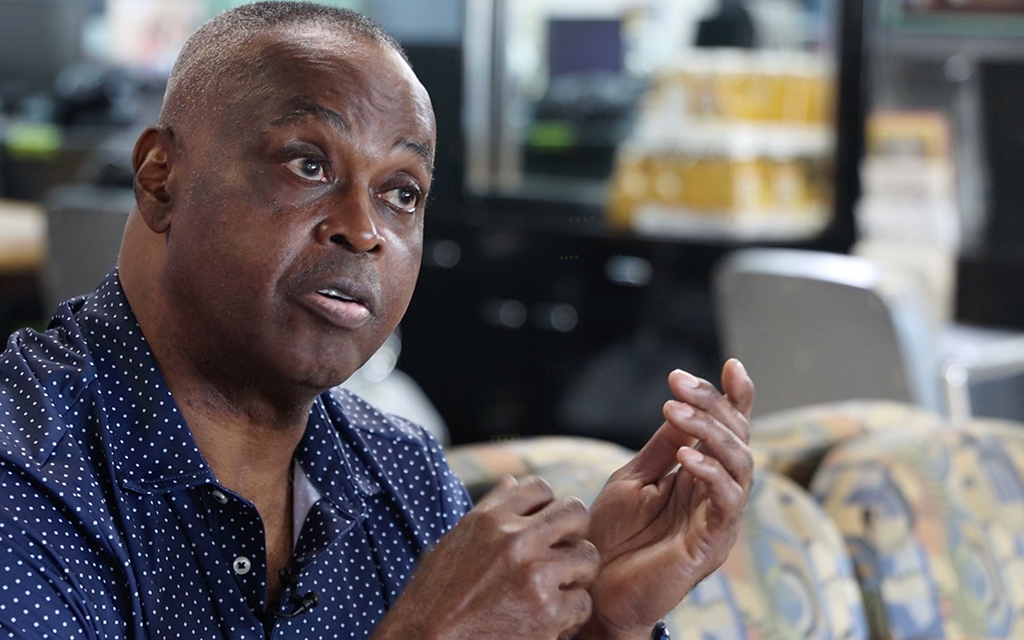
John Solomon is a former police officer and a member of the Brooklyn Center, Minnesota, implementation committee. (Photo by Diannie Chavez/News21)
John Solomon, a former police officer who also is on the Brooklyn Center implementation committee, said banning low-level traffic stops means officers have more time to handle serious crimes.
“I think it wouldn’t affect them in any way negatively at all,” Solomon said. “I think that it would probably free them up to do other things here.”
Critics of such policies argue that reducing stops will lead to an increase in crime and traffic accidents. But a 2020 study of stops in Fayetteville, North Carolina, published in BMC, said reprioritizing traffic stops “may have positive public health consequences both for motor vehicle injury and racial disparity outcomes while having little impact on non-traffic crime.”
It’s unclear whether the traffic bans have a permanent impact on racial disparities, but traffic stops have dropped in several cities across the country. In Washington state, the Seattle Times reported earlier this year that traffic stops “plummeted” after Police Chief Adrian Diaz halted the use of vehicle registration and other minor infractions as a “primary basis” for stops.
A Bloomberg CityLab data analysis in September 2020 showed an 80% drop in Minneapolis traffic stops in the three months after George Floyd’s death.
Thomas, the Philadelphia council member, said traffic stops have dropped significantly for minor motor vehicle code violations. According to data the city has made available, stops have decreased by 65% in 2022, compared to pre-pandemic levels.
But he thinks there are bigger issues at stake, including how the city enforces crime.
“I hope it begins to build the bridge back between communities of color and law enforcement,” Thomas said.
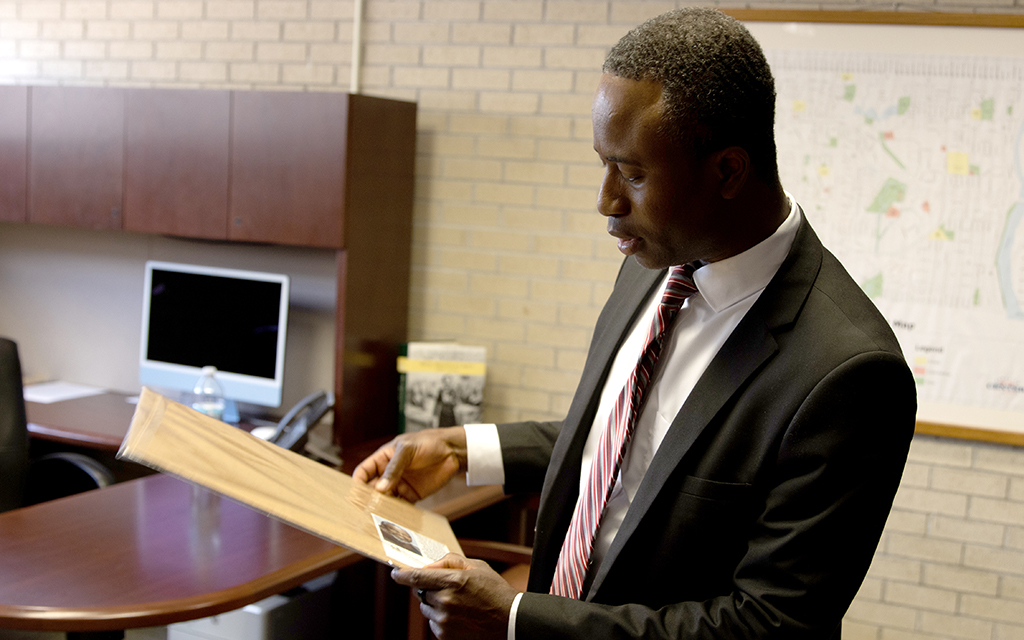
Mike Elliott, mayor of Brooklyn Center, Minnesota, shows reporters a painting by a local artist on Saturday, July 9, 2022, in Brooklyn Center. (Photo by Diannie Chavez/News21)
Police out of the picture
Other cities are considering removing police from interactions altogether.
Berkeley, California, and Brooklyn Center have proposed a seismic change in who conducts traffic stops – rather than armed police, unarmed civilians would be in charge.
Brooklyn Center officials intend to create a civilian Traffic Enforcement Department to restrict or possibly eliminate certain nonmoving violations, according to a resolution adopted in May 2021 by the City Council. The resolution also sets up new departments for other reforms, such as community response to mental-health calls. A grant from Blue Cross Blue Shield provided about $260,000 for the initial stages of the traffic department.
Mayor Elliott estimates the changes for all proposed reforms will cost about $1.3 million per year.
California doesn’t allow civilian traffic enforcement, but Berkeley city leaders proposed BerkDOT to create a civilian traffic unit.
Berkeley officials had discussed hiring a consultant to advise on a potential campaign to change state laws to allow for civilian enforcement, but in an email, Matthai K. Chakko, the city’s communications director, said they have no timetable and are prioritizing other issues.
More common reforms employ technology – red light cameras, speed cameras and a nascent texting program – which are promoted as a contactless, friction-free way to enforce traffic laws and maintain safety. Critics say automated enforcement maintains another longstanding system with built-in biases – traffic fines as revenue generators that unfairly affect the people who can least afford it.
Thomas said technology can help.
“We’re using technology to do this interview,” he said. “We can use technology to cite people for minor motor-vehicle code violations, we can mail them tickets, we can email them tickets.”
Communities across the country have already adopted some form of technological enforcement.
The National Transportation Safety Board, in a 2017 study, lauded the trend as a positive for safety. Today, nearly 25 states augment their traffic enforcement with either red light or speed cameras.
“Automated speed enforcement is an effective countermeasure to reduce speeding-related crashes, fatalities, and injuries,” the report said.
But critics say even automated enforcement can reinforce racial disparities in policing. A 2018 study of camera violations in the District of Columbia found that drivers in predominantly Black neighborhoods received more moving violations and higher fines than drivers in predominantly white areas.
“What the researchers found was that the combination of where they put the cameras and the really low thresholds of ticketing people resulted in a larger racial disparity in enforcement overall, and more Black and brown drivers getting ticketed,” said Samuel Sinyangwe, a data scientist and founder of Mapping Police Violence. “Automated enforcement might be one option, but it has to be done in a very conscious way that can ensure that we’re not just replicating the same systems and making them worse.”
Rau, with the Center for Policing Equity, doesn’t recommend red light cameras as an alternative to a real-life officer, especially because most departments don’t prioritize such traffic violations.
“In my experience, police officers don’t typically sit by intersections waiting for someone to run a red light,” Rau said. She sees a risk that the cameras can become less about public safety and more about raising revenue for departments and third party companies who lease the cameras.
Rau also cautions that speed cameras have high error rates and should only be considered in locations with crash histories and with community consent.
“It can still create ticket debt,” Rau said. “It can still create the harms associated with that.”
Although most municipalities require infractions caught on camera to be reviewed by a sworn officer, there are still challenges with privacy, enforceability and constitutionality. Eleven states have banned red light cameras, speed cameras or both after successful legal challenges.
“You didn’t have the police pulling people over,” Sinyangwe said. “So there probably was a reduction in police contact, and, in particular, contact that might have resulted in use of force. But that’s not a win to ticket a whole bunch more people and, particularly, Black and brown people. That’s not an approach we want to replicate across the country.”
Trusted Driver, a San Antonio company, is piloting a program with departments in Texas and Nebraska that allows officers to communicate with drivers, and even issue citations, through text messages.
Drivers who sign up for the web service can include medical conditions, physical disabilities, communication disorders or weapons information. Providing additional information to the officer before the stop will help with potential miscommunication should the officer make a stop.
They also can communicate through text and avoid interaction altogether.
“What would you prefer – the chance of an encounter going poorly, or the prospect of a non-physical citation being issued electronically?” asked Wallace Jefferson, former chief justice of the Texas Supreme Court and a supporter of Trusted Driver. “And it just seems to me the latter is the way to go.”
Lights On!, a Minneapolis nonprofit, has a different approach. It works with police and auto-repair shops to offer motorists free car repairs rather than traffic tickets. Drivers can receive up to $250 to fix such things as taillights.
“When a person is starting to get a voucher, they’re having a conversation with their individual to where it gets communicated in a positive way,” said Sherman Patterson, vice president of Lights On!
Rau believes the best solution is to eliminate low-level stops altogether, as the Center for Policing Equity recommends.
“I am encouraged that we are seeing cities do what Virginia did, what Philly did, what Pittsburgh did. Those are major changes,” Rau said. “What Berkeley and Brooklyn Center are looking at, those are big.”
Other possibilities are decidedly low tech, like improved communication between police and the people they’re supposed to serve and protect.
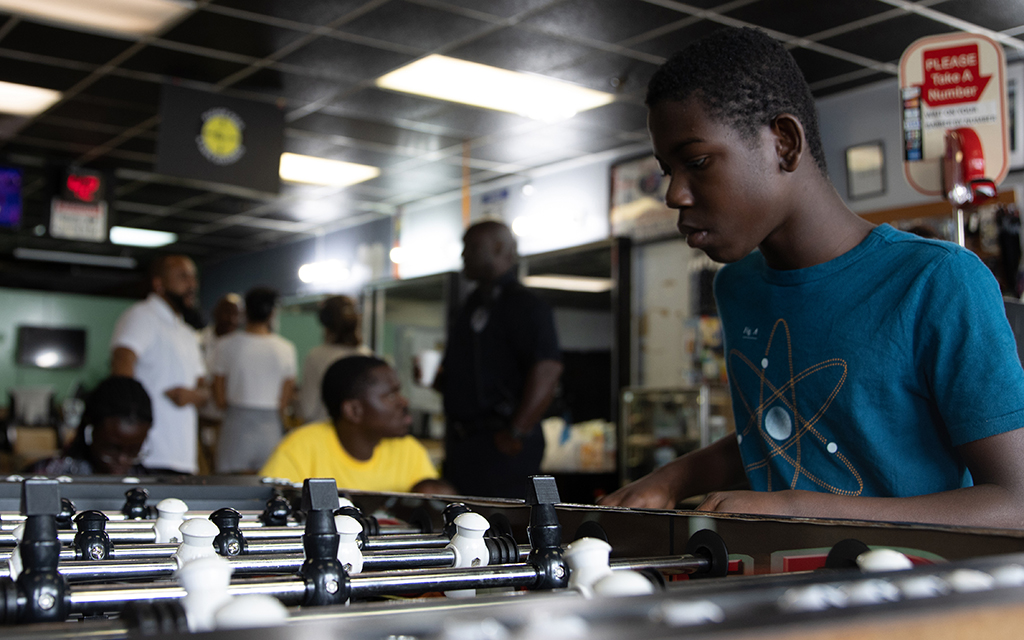
Isaac Johnson plays foosball while he waits his turn in the chair at Handz-On Barber & Beauty in Brooklyn Center, Minnesota, on Thursday, July 7, 2022. The shop is packed with people as owner Phillip Musa hosts a “coffee with the city manager” forum. (Photo by Diannie Chavez/News21)
In Brooklyn Center, Handz-On Barber & Beauty hosts gatherings where kids play foosball and listen to music while customers get their hair done and talk to the city manager and other city officials.
But not all coffee and conversation is easy.
Wright acknowledges tensions and pushback to Brooklyn Center’s implementation committee on police reforms. Some have expressed skepticism the city will receive federal funds to back changes in the long term. Passing a resolution to change traffic enforcement is one thing. Getting it done is another.
“I think that when people look at this, too, they’re looking at two sides, right?” Wright said. “They’re looking at the resolution and the implementation committee side, and then they’re looking at the police side and they’re not realizing that, no, we need to come together to make it happen and not be divided. We’re not asking for anyone to pick sides. We’re just asking for people to be safe.”

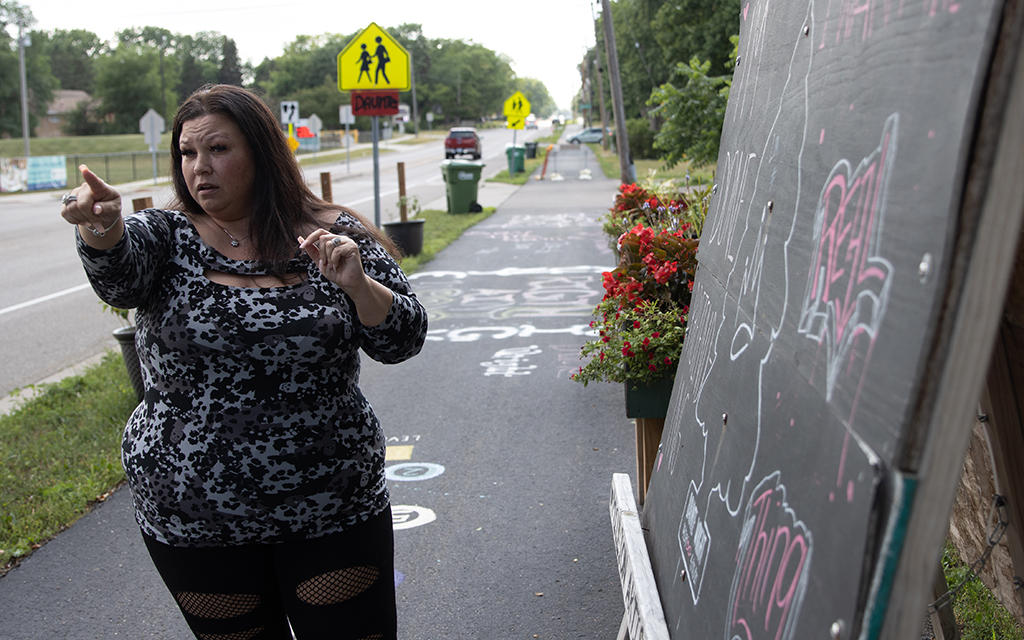
Left: Katie Wright visits the Daunte Wright memorial in Brooklyn Center, Minnesota, on Friday, July 8, 2022. Minutes before he was fatally shot, Katie Wright says, Daunte called to tell her he had been pulled over for air fresheners dangling from his rearview mirror. Right: Katie Wright visits the Daunte Wright memorial in Brooklyn Center, Minnesota, on Friday, July 8, 2022. The memorial is at the intersection where her son, Daunte Wright, was killed by an officer who said she mistakenly reached for her handgun instead of her Taser. (Photos by Diannie Chavez/News21)
Top: Katie Wright visits the Daunte Wright memorial in Brooklyn Center, Minnesota, on Friday, July 8, 2022. Minutes before he was fatally shot, Katie Wright says, Daunte called to tell her he had been pulled over for air fresheners dangling from his rearview mirror. Bottom: Katie Wright visits the Daunte Wright memorial in Brooklyn Center, Minnesota, on Friday, July 8, 2022. The memorial is at the intersection where her son, Daunte Wright, was killed by an officer who said she mistakenly reached for her handgun instead of her Taser. (Photos by Diannie Chavez/News21)
‘For my grandkids, for your grandkids’
Wright often visits the memorial to her son. She crosses her legs as she sits down next to a bed of primroses, nestled next to where her son died. It’s a familiar stop.
Later this month, on her son’s birthday on Oct. 27, she’ll be sure to be there. And she’ll continue the battle for reform.
“I feel like that is my fight right now, if not for Daunte, because Daunte is already gone, but for my grandkids, for your grandkids, for your neighbor,” Wright said. “I always tell everybody, even if you don’t have any person of color in your family, people of color affect everybody in America. So do it for them, and that’s why I’m doing it.”
Her hopes and dreams involve meeting with other police departments, telling her story and persuading them to change their ways.
“I’m hoping the future of traffic stops is only being done if it is causing an immediate danger,” Wright said.
One day, reform advocates say. Maybe.
“I think that there’s going to be a day where there’s very little need for traffic stops,” said Elliott, the Brooklyn Center mayor. “There’s just no place for people being pulled over, en masse, in the United States of America. In the future, it’s archaic.”
News21 reporter Nina Howard contributed to this article. James Doyle Brown Jr. is an Arnold Ventures Fellow.
Top photo credit
Katie Wright sits at the Daunte Wright memorial in Brooklyn Center, Minnesota, on Friday, July 8, 2022. The garden marks the spot where her son took his last breath after being shot in April 2021 by a Brooklyn Center police officer who said she mistook her pistol for her Taser. (Photo by Diannie Chavez/News21)

